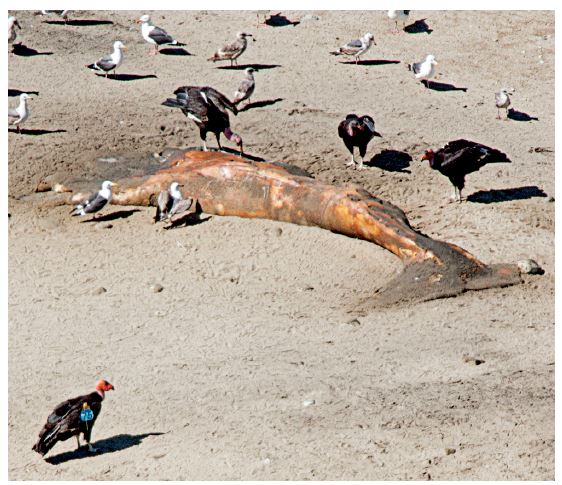DDT Contamination Still a Problem for Condor Eggs, Even in 2013
By Hugh Powell
October 15, 2013

In 2006, a California Condor pair was found nesting in a massive hollow high in a redwood tree on the Big Sur coast. The discovery seemed like another step forward in the condor’s slow walk back from extinction. At last the majestic birds had returned to the central coast. They were once again feeding on dead sea lions and gray whales, just as Spanish missionaries had described in the 17th century.
“Just on a personal level, you see them feeding on whales and nesting in redwoods, and it takes you back to a thousand years ago,” said Joe Burnett, who coordinates the Big Sur condor project at the Ventana Wildlife Society.
But the good news was soon tempered. The nest was not successful, and later, when biologists climbed into the cavity, they found an ominously familiar piece of evidence: fragments of thinned eggshell.
They continued monitoring 84 condors released in Central California—in Big Sur and at Pinnacles National Monument—eventually discovering thin eggshells in at least 6 of 16 eggs laid between 2006 and 2010. They published their findings this summer in the journal Condor.
To most of us, DDT is a cautionary tale that ends happily in the 20th century. Before its devastating environmental effects became apparent, DDT was hailed as a miracle pesticide and won its inventor a Nobel Prize. At first used indiscriminately, it was banned in the United States in the early 1970s. By the 1990s, Brown Pelicans, Ospreys, and other birds whose numbers had plummeted were making strong recoveries. Lesson learned.
But it turns out that the ocean still contains DDT, particularly in Southern California, where a factory’s discharges created the single most DDT-polluted waters on the planet. Animals metabolize DDT to produce DDE, which accumulates in animals at the top of the food chain. And a condor that feeds on dead sea lions is about as high on the food chain as it can get.
California sea lions become exposed to DDT compounds during their breeding season in Southern California, and then migrate north to fishing grounds on the Big Sur coast. It’s a sign of success that condors have learned to find and eat dead sea lions on their own, but it’s also a threat to their health. “That’s the toughest thing as a biologist,” Burnett said. “To see those birds doing the right thing. They’re out there foraging on their own, and it’s actually counterproductive.”
The researchers collected fragments from 12 eggs and compared them with eggs from condor nests in Southern California, where the birds do not feed on marine mammals. They measured the eggs to the nearest 0.1 millimeter and examined them with scanning electron microscopes. The Central California eggs were on average just two-thirds as thick as Southern California eggs.
California Condors lay sturdy eggs that, even when thin, don’t often get crushed underneath them. “But condor eggs don’t necessarily have to be crushed to fail,” Burnett said. Thinned shells lose water an average of three times faster than normal eggs, often causing the developing chick to die. (The researchers moved some of the eggs to the Los Angeles Zoo, where keepers placed them in incubators and cranked up the humidity, saving two chicks.) Electron microscopes revealed that many shells were missing a protective crystalline outer layer, making infection more likely.
Still, Burnett and his colleagues are hopeful the big birds can weather this problem. Because of the way condors store DDE, long-term exposure is not as likely to cause eggshell thinning as short-term exposure. And with DDT production shut down, short-term exposure levels should begin to abate.
That leaves the condor’s other—and much bigger—contamination problem: lead ammunition. Condors are such good scavengers that they often wind up eating highly toxic lead shot left on the landscape. Between DDT and lead there’s no comparison. “We’re talking about impaired reproduction versus death,” Burnett said. “That’s a deal killer. Lead is trumping everything right now.”
In the meantime, the reappearance of eggshell thinning adds one more chapter to the tale of DDT. If DDT has had time to become a hopeful lesson—that humans really can learn to recognize and correct our mistakes—it’s also a reminder that even 40 years is not long enough to redress the damages of a technology eagerly adopted before it was fully understood.
Reference
Burnett, L. J., et al. 2013. Eggshell thinning and depressed hatching success of California Condors reintroduced to Central California. Condor 115:477–491.


All About Birds is a free resource
Available for everyone,
funded by donors like you









